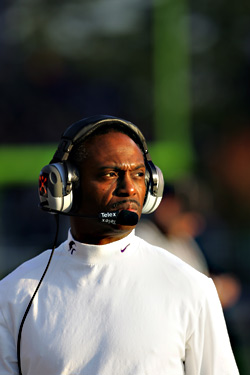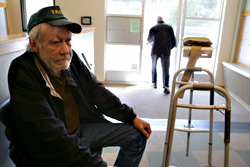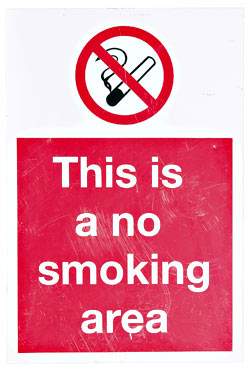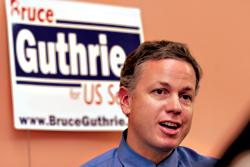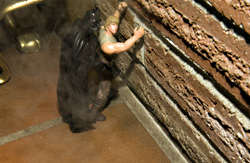Isaiah Stanback dropped back to pass on third and 10 against the Fresno State Bulldogs on Sept. 16 at Husky Stadium. It was a game that wasn’t going the mercurial quarterback’s way, as the opposing Californians had bottled up the Dawgs’ passing attack for much of the first half and locked the Huskies in a 14-14 third-quarter tie.
Since becoming the Huskies’ starting quarterback last season, Stanback had weathered complaints from media and fans alike for trusting his sprinter’s speed more than his rocket arm. He wasn’t seeing a play open up before him the way a star quarterback ought to, went the criticism.
Tyrone Willingham, the Huskies preternaturally calm second-year head coach, teaches his quarterbacks to “work with what the defense gives you”—in essence, to turn lemons into lemonade. And on this third down, despite the fact that Fresno State had his receivers well covered, Stanback was all of a sudden drinking lemonade. Instead of making a break for it on his own, as his critics might expect him to do, Stanback rolled left, stopped, and rifled the football 15 yards to receiver Marcel Reece for a crucial first down.
From Husky Stadium’s vertigo-inducing press box, it was hard to miss the brilliance of Stanback’s decision, a symbol that, finally, the lightbulb had flipped on in the quarterback’s cortex, and that the Dawgs might begin performing like the perennial Husky powerhouses of old. The glimmer of hope was there, at any rate, and the Huskies went on to squeak out a win in a game they’d been expected to lose.
Asked what he thought about the third-down play, Willingham responded as if it were an average Stanback moment, something the Garfield High School graduate did on just about every snap.
“He executed the fundamental law of being a quarterback,” Willingham said, in his tightly controlled, engineerlike, enigmatic way. “Take what they give you.” (After suffering a season-ending foot injury against Oregon State four weeks after the Fresno State game, Stanback won’t be taking anything more in a Husky uniform.)
That’s the essence of Willingham’s public face: He answers questions in a way that is as tight-lipped as a State Department spokesperson—to the point where Seattle Post-Intelligencer columnist Jim Moore has dubbed him “Paint Dry Ty.” In short, everything former head coach Rick Neuheisel was, Willingham is not.
This is probably a good thing. While Neuheisel guided the Dawgs to a Rose Bowl victory in 2001 and had the program seemingly poised for a return to its rightful throne among the country’s top powerhouses, the “Slick Rick” reputation that followed him from his previous gig at the University of Colorado manifested itself in the form of recruiting and gambling violations that helped set the proud Husky program back half a century. Willingham was hired before the 2005 season to do nothing less than restore the program’s integrity and re-establish the Huskies as a perennial Top 25 team. How fast must this turnaround occur? Willingham’s five-year contract—three years remaining after this one—is probably a pretty generous window, for Husky boosters are not known as a patient lot.
Despite his standoffish reputation, Willingham maintains: “The truth of the matter is I’m very open. I find it difficult to give more information than I have.”
Yet when Willingham busies himself juggling questions, a half-smile forms and his eyes actually twinkle like he’s about to become Tyrone the Ad-Libber. But then he doesn’t follow through on what he’s thinking. It’s as if what he’s pondering is too subtle for words.
You could sense this during Willingham’s press conference after a come-from-behind 29-19 victory (the Huskies trailed 16-0 at one point) over UCLA at Husky Stadium on Sept. 23. After the game, I asked him: Why was the Husky offense sputtering so badly in the first half (total rushing: minus 8 yards), yet so on fire in the second?
“Sputtering?” Willingham responded, the smile creeping out. “You are being very kind to describe it as sputtering. I would’ve used a different term.”
Once the television cameras started rolling, Willingham called his offense “struggling”—and moved on to the next question.
The 52-year-old Willingham is built like a middleweight wrestler and favors a preppy wardrobe that suggests an Ivy League literature professor. He was a walk-on quarterback at Michigan State, starting four games in 1973 as a freshman before seeing little playing time the rest of his career. After college, he moved into coaching, serving as an assistant to Dennis Green at Stanford and with the NFL’s Minnesota Vikings, where Willingham coached the team’s running backs. He then returned to Stanford as head coach in 1995, succeeding the legendary Bill Walsh.
Willingham is one of five African- American head coaches in Division I football (last year, it was three out of 118 schools). Asked when that ratio might improve, Willingham says it won’t.
“It never will because of man’s nature,” he says. “Man has to have someone beneath him. In America, it’s a racial line. In the Middle East, I guess it’s a religious one.”
On matters of the gridiron, Willingham’s strong suit is answering strictly what’s put before him, factually and philosophically, by turns.
“If our players listen to me, they will learn that the word ‘frustration’ is not in my vocabulary,” he says. “Frustrations are things you cannot change.”
Willingham is not above poking fun at his taciturn public image, however. Last year, the athletic department began airing ads featuring Willingham and men’s basketball coach Lorenzo Romar, with the coaches sitting on a bench on the UW campus. Romar, who’s far more outwardly personable than Willingham, tells the football coach that he needs to learn how to tell jokes and offers up the classic “horse goes into a bar” quip as an example.
Willingham sits there, unfazed; and then pinches out a small smile.
“I see Tyrone as very businesslike,” says Ernie Dunston, president of the Breakfast Group, composed of local black business and civic leaders, including Willingham, who meet monthly. “But he has a wonderful dry sense of humor. He likes to have breakfast and talk and be one of the guys.”
Yet Willingham’s modus operandi throughout his tenure as Stanford’s head coach (1995–2002, during which he took the Cardinal to its first Rose Bowl since 1972) and his tumultuous three seasons at Notre Dame (2002–2004) has been to keep the public at bay. This tight-lipped tactic drives the media bonkers.
“I was just sitting there one day watching him and thinking, ‘This is like watching paint dry,'” says Moore, the P-I columnist and arch rival Washington State University partisan. “His whole deal is boring and dull. He won’t let anybody in. He takes a perverse joy in it.”
Reporters and fans would love to know the nuances of Willingham’s thinking and the subtle mechanics of why the Huskies win or lose—answers to questions like: Why isn’t Jake Locker starting? Why can’t Louis Rankin pound the defensive line more often? Why is the pass blocking consistently subpar? Yet, without fail, they get something more along the lines of a CEO talking about his company’s quarterly stock performance.
As if to prove his disregard for minutiae, Willingham stood patiently after a formal press conference one Monday as Hugh Millen, the KJR-AM football commentator and a former Husky and NFL quarterback, asked a complicated question about why Stanback wasn’t picking up defensive shifts during a game and calling for protection changes. Millen even got into a quarterback’s stance and demonstrated what he meant.
“If he could do that, he would be the smartest quarterback in the history of college football,” said Willingham, nodding his head slowly.
Since Stanback’s season-ending injury in mid-October, the press has hounded Willingham about when he will start redshirt freshman—and alleged savior—Locker. In the weeks following the Oregon State game, the sporting press and some fans have doubted the ability of backup Carl Bonnell. So when Bonnell was knocked out of the Arizona State game after a fourth-quarter concussion, the television cameras immediately went to Locker standing on the sideline.
But Willingham sent Johnny DuRocher into the game. The third-stringer managed to go 4 for 8 passing against a blitzing ASU defense, throw a touchdown pass, and engineer a comeback that forced overtime. But for the second week in a row, the Huskies lost a nail-biter. DuRocher walked up the tunnel to the Husky locker room, hanging his head.
After the game, Willingham described this wild ride as “disappointment [in reference to the first three quarters of play], excitement [the comeback], disappointment [the overtime loss]” and left it at that.
Two days later, at his regular Monday afternoon press conference, Willingham fielded the Locker question three times. He was asked how Locker was handling not playing when fans were screaming for him.
“He’s in a very difficult situation because he’s hanging out there in limbo to a degree,” Willingham said.
“Have you ever sat down with him and said, ‘We are weighing this decision’?” inquired Millen.
“Yes,” Willingham said. “I get a feeling he’s ready to go but that he’ll let us make the right decision.”
“Did he express a desire?” asked Millen.
Willingham smiled before replying: “Yes. That he’s ready to go.”
Jim Lambright, for one, admires Willingham’s reserve.
“It’s a change,” says Lambright, who, prior to serving as Husky head coach from 1993 to 1998, was a longtime assistant under Don James. “And the challenge now is for the press to accept that this is the way he’s going to go about doing his business. There’s nothing phony about it. If he were to change, I would worry because I would think it was something he was forced to do rather than something that comes naturally to him.”
The Huskies had been awful over the two seasons prior to this one, winning a combined three games. The program was in shambles following scandals involving its coach and the university’s athletic department at large. Yet as recently as 2001, the Huskies were coming off a Rose Bowl win and looked to be getting back to the program’s dynasty days of conference championships and Top 10 rankings.
But the football team had an albatross around its neck in the form of coach Rick Neuheisel. The former UCLA quarterback had come to UW in 1999, hired by then– athletic director Barbara Hedges, and was regarded as being a bit of a shifty character for his conduct at the helm of the University of Colorado football team, which contended for major bowl titles alongside NCAA recruiting violations that occurred on Neuheisel’s watch.
In spite of his early success, many Husky loyalists blanched at how Neuheisel ran his offense, which was perceived as soft compared to the James and Lambright eras.
“I think that he did to UW exactly what he did to the University of Colorado,” says Lambright. “[Rick] took away all the toughness and recruited a very unbalanced team. It was an attempt at building a star system.”
Neuheisel ultimately ran afoul of NCAA regulations, was sanctioned, censured, and caught gambling on NCAA basketball. He was fired in 2003, a move that he fought in court against both UW and the NCAA (Neuheisel reached a $4.7 million settlement with the two entities in 2005).
As if to complete the cycle, the UW athletic department doctor was caught giving illegal prescriptions to softball players. Not only was the football program out of control, so was the entire athletic department. Hedges retired in 2004. She was replaced by straitlaced Todd Turner, who, like Willingham, was tasked with cleaning up the department and returning the football team to its glory days.
Halfway across the country, Notre Dame had just completed a lackluster season, going 6-5. As a result, after three years as head coach in South Bend, Ind., Willingham was sent packing. While at Notre Dame, he’d assembled a good roster of talent, instituting the same system that had made Stanford—his first stop as an NCAA head coach—competitive after decades near the bottom of the Pac-10 heap. His major sin at Notre Dame, aside from not winning a major bowl game, was not beating arch rival USC during his tenure.
So Willingham was without a job, UW was without a coach, and a marriage of convenience occurred: Willingham became the Husky helmsman in December 2004, signing a five-year deal for about $1 million a year in salary and other compensation.
His first season was a disaster. The team flailed, ending the season 2-10 with an Apple Cup loss to WSU. But in the ensuing off-season, Willingham pulled off a coup, successfully wooing Ferndale’s Locker, rumored to be the state’s best prep quarterback in quite some time.
Coming into this season, things nonetheless looked bleak. Scott White, a senior linebacker, almost quit the team, and the press nitpicked Willingham for his decision to redshirt Locker in favor of keeping Stanback as the Huskies starter.
Moments after the Fresno State win, with the team’s record at 2-1, Willingham entered the press room, as disinterested in the proceedings as if he were at a bus stop watching traffic.
“I know the first question is going to be: ‘How does it feel?’ And it feels good,” said Willingham. “It’s the next best thing to 3 and 0.”
Yet so listless had the Husky offense been in the first half against the Bulldogs that, before play resumed in the second half, Willingham had his charges run through two plays on the playing field in front of 50,000-plus fans, a visual scolding of sorts.
Asked about that maneuver, Willingham said: “Well, we’ve been known to start slow in the third quarter, so we thought we’d get out there and get them moving early. We ran a few plays during halftime to jump-start our guys, but I think the sequence was we didn’t move the ball, and then Fresno State scored.”
The next week was better for Husky fans, as UW shook off a 16-0 halftime deficit to beat UCLA 29-19. If the Fresno State game indicated that the Huskies finally had some power under the hood again, then the come-from-behind UCLA victory showed that the team had some magic. After a win against Arizona the following week, the team was clearly on a roll at 4-1, possibly even bowl bound for the first time in four years.
The Huskies lost their next outing at Southern Cal, but the game was a moral victory because UW was in a position to take a shot at the USC end zone with two seconds left. At his Monday press conference following that game, Willingham fielded questions about those two seconds for 40 minutes. Some in the press said that the official had held UW’s center off the ball too long, and that the referee hadn’t wound his arm, an indication that the clock should start. What did Willingham think of the officiating?
“We’ve got to be up on the ball, ready to go—and that’s my job,” replied Willingham, taking the high road when he could have been excused for being a tad bitter.
Later, Willingham fielded a question about Stanback, who’d been consistently outstanding since the first-half debacle against UCLA. How had Stanback grown so quickly after having looked so lost earlier in the season?
“There’s a rule we have: Take what they give you,” Willingham said, reiterating his quarterback credo. “If you violate that law, you get in trouble.”
Back at Husky Stadium the next Saturday, the Dawgs faced a charged-up Oregon State team and were outplayed all day, losing 27-17. More critically, however, they lost Stanback for the season. The team fell to 4-4 the next week after losing 31-24 in overtime to the nationally ranked California Bears.
Compared to his experience at Notre Dame, where he was savaged after the mediocre 2004 season, Willingham has little to worry about. Before this season, the Huskies were picked to duke it out with Stanford for last place in the Pac-10, winning perhaps three games tops.
“I love it,” says Lambright. “I thought before the season, if they got four wins, then it would be one heck of a year. If they can put six together, I’ll be first in line applauding Tyrone.”
The evening after the ASU game, another heartbreaking overtime loss that left the Huskies at 4-5 with much-diminished chances of making the postseason, 60 Minutes aired a feature on Willingham’s successor at Notre Dame, Charlie Weis. In his second season, Weis has the Irish ranked in the Top 10; and Steve Kroft, a 60 Minutes correspondent, remarked that Weis had remedied the school’s recent lack of commitment to winning and academic excellence.
Willingham said he hadn’t seen the 60 Minutes piece, but when told of Kroft’s assertion, he had an uncommonly charged response.
“Oooooooh,” he said, before stopping abruptly. One thing Willingham prides himself on is making sure his student athletes make it down the aisle in a cap and gown on graduation day. At Stanford, his graduation rate was 94 percent—95 percent at Notre Dame. (At UW, the grad rate has hovered in the 60 percent range, something Willingham wants to improve.)
Willingham has consistently refused to comment about his experience at Notre Dame, but how would he respond to patently erroneous information that called his integrity into question?
“I wouldn’t respond,” he said.
For sportswriters and fans, the Willingham style doesn’t make for fascinating reading and viewing. He processes a win on the same emotional level as a loss, except that it’s a win—and wins are inherently better than losses.
Not that some sportswriters don’t work overtime trying to crack Paint Dry Ty.
“You like candy as a kid?” the P-I‘s Moore asked Willingham last week, looking for some kind of Halloween column hook. A moment before, he’d asked Willingham about his favorite Halloween costume as a child. Willingham, who grew up in Greenville, N.C., and was among the first African-American students to attend a previously segregated high school, told Moore that he didn’t have a favorite costume—that the most he might have worn was a mask.
“Candy’s good,” said Willingham.
“So you liked Almond Joy?” asked Moore, almost laughing at himself.
Willingham nodded and replied: “They’re good.”
“I could ad-lib everything,” says Willingham, when asked about his Paint Dry Ty, Boy Scout image, “but I don’t like repeating facts. I am very honest and up front. So many of us are trying to put a particular spin on things. I come to you with no agenda. What it is is what it is.”
